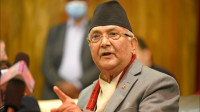National
Commission to dig up sites in search of missing persons
Disappearance commission set to excavate possible places where victims could have been buried after being killed by either the state or rebel forces.
Binod Ghimire
Seven years after its formation, the Commission of Investigation on Enforced Disappeared Persons is set to dig up suspected burial sites of the people who were disappeared during the decade-long Maoist insurgency.
Ever since the formation of the commission in February 2015, it has received 3,223 complaints of enforced disappearances perpetrated by both the state security forces and the Maoists. After a preliminary investigation, the commission has identified 2,484 cases as genuine although the International Committee of the Red Cross says 1,333 people are still missing in connection with the armed conflict.
As it has been 15 years since the insurgency ended following the signing of the Comprehensive Peace Accord between the insurgency leaders CPN-Maoist and the government in November 2006, many of the victims of enforced disappearances are believed to have died. The commission is planning to carry out exhumation at the possible places where the victims could have been buried after being killed either by the security forces or the Maoist fighters.
Gangadhar Adhikari, a member and spokesperson at the commission, said they have received reports on about 60 spots where disappearance victims could have been buried. “Of them, we, supported by forensic experts, have identified seven places where exhumation can be carried out,” he told the Post. “We plan to complete these exhumations before the expiry of our current term.”
The terms of the existing teams at the disappearance and the Truth and Reconciliation Commission expire on July 16. The existing Enforced Disappearances Enquiry, Truth and Reconciliation Act must be revised to further extend the terms of the commissions.
To start the work, the disappearance commission is planning to dig a suspected burial site in the Lumbini Province. Adhikari claimed that all the preparations for exhumations have been completed. He said Nepali forensic experts are experienced in exhuming solitary graves but carrying out exhumation in a mass grave is complicated and they have no experience. “It is possible that there could be more than one dead body in the graves we are planning to dig up,” he said. “The International Committee of the Red Cross has promised support. The commission is forging an agreement with the committee in a couple of weeks.”
He said the International Red Cross will provide international forensic experts under whose supervision the grave will be dug up.
Dr Harihar Wasti, a forensic expert and a professor at the Tribhuvan University Teaching Hospital, and Rijen Shrestha a forensic expert at the commission, will be taking lead of the exhumation work. “We have exhumed bodies from solitary graves, but digging up mass graves is a complex process so we need some experienced professionals to supervise the work,” Wasti told the Post.
Wasti was in a team that exhumed the grave of Maina Sunar inside the Nepal Army’s Panchkhal Barracks in Karvepalanchowk in March 2007. The army had killed and buried her on the barracks premises saying she was a Maoist combatant. Similarly, journalist Dekendra Thapa’s body was exhumed from a jungle in Dailkeh in June 2008. He was abducted by members of the then CPN-Maoist in August 2004 and buried in the jungle after being killed. Similarly, a mass grave was dug up with the support of international forensic experts in February 2011, from a site near the Kamala River, at Godar of Dhanusha. The remains of five students, who were killed by security forces, were recovered from the site.
“We have experience of digging up around 15 graves with the support of the international experts and by ourselves,” said Wasti. The victims of the families of enforced disappearances have been demanding that the government should tell them whether their dear ones are alive or dead.
With the commission failing to provide justice to the victims, some of the victim families are turning to the regular justice system by lodging complaints with the police. They are turning to the regular justice system as the Penal Code-2017, which came into effect in 2018, has criminalised enforced disappearance.
Section 206 (1) of the Penal Code prohibits enforced disappearance and lists it as a criminal offence, the first time in Nepal’s history. Anyone convicted of disappearing an individual can face 15 years in jail and Rs 500,000 fine or both. If the victim of enforced disappearance is a child or a woman, the sentence could be increased to 17 years.
Except for providing a compensation of Rs1 million per victim family, there has not been any progress in providing justice. The report of the disappearance commission shows as many as 1,227 victim families have received the compensation so far.
“We have been demanding that the government produce our loved ones–either alive or dead,” said Conflict Victims Common Platform Secretary Rupesh Shah, whose brother was disappeared by security forces during the insurgency in May 2002. “If the commission finds bodies then it should also find out who killed them and book the perpetrators.”




 5.39°C Kathmandu
5.39°C Kathmandu










%20(1).jpg&w=300&height=200)



